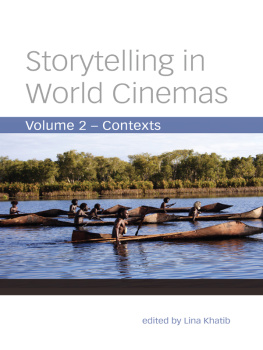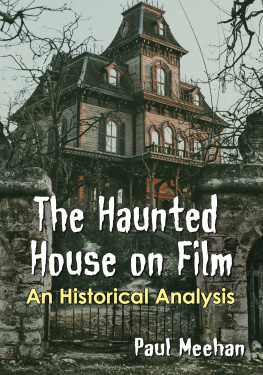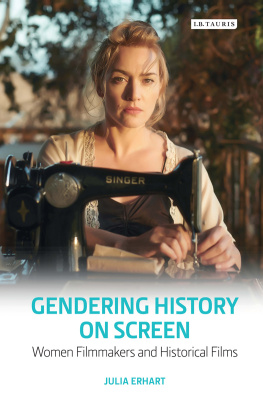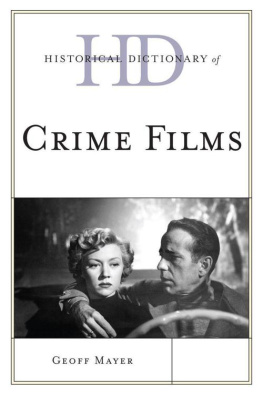INSIDE THE HISTORICAL FILM
Inside the Historical Film
BRUNO RAMIREZ
McGill-Queens University Press
Montreal & Kingston | London | Ithaca
McGill-Queens University Press 2014
ISBN 978-0-7735-4420-8 (cloth)
ISBN 978-0-7735-4421-5 (paper)
ISBN 978-0-7735-9647-4 (ePDF)
ISBN 978-0-7735-9648-1 (ePUB)
Legal deposit third quarter 2014
Bibliothque nationale du Qubec
Printed in Canada on acid-free paper that is 100% ancient forest free (100% post-consumer recycled), processed chlorine free
This book has been published with the help of a grant from the Canadian Federation for the Humanities and Social Sciences, through the Awards to Scholarly Publications Program, using funds provided by the Social Sciences and Humanities Research Council of Canada.
McGill-Queens University Press acknowledges the support of the Canada Council for the Arts for our publishing program. We also acknowledge the financial support of the Government of Canada through the Canada Book Fund for our publishing activities.
Library and Archives Canada Cataloguing in Publication
Ramirez, Bruno, 1942, author
Inside the historical film / Bruno Ramirez.
Includes bibliographical references and index.
Issued in print and electronic formats.
ISBN 978-0-7735-4420-8 (bound).
ISBN 978-0-7735-4421-5 (pbk.).
ISBN 978-0-7735-9647-4 (ePDF).
ISBN 978-0-7735-9648-1 (ePUB)
1. Historical films History and criticism. 2. Motion pictures and history. 3. Motion picture producers and directors Interviews. I. Title.
| PN1995.9.H5R36 2014 | 791.43658 | C2014-903086-X |
| C2014-903087-8 |
Set in 9.5/13 Range Serif with Range Sans
Book design & typesetting by Garet Markvoort, zijn digital
I dedicate Inside the Historical Film to my students, past and present, whose quest for knowledge and understanding whether authentic or utilitarian has led me to give my best in sharing with them the meaning of the past to our lives.
CONTENTS
PREFACE
Unlike most scholarly monographs, this book is not the result of a formal research project channelled through various funding agencies and calling for research assistants and writing leaves. Instead, it has grown over the years from the countless discussions I have had with film viewers in classrooms, at conferences, and in various public forums. I was particularly fortunate to be invited by the University of Paris Diderot (Institut Charles V), Glendon College (York University), the University of Trier, and the University of Bologna to teach courses or give lecture series on Canadian history or on immigration history using the films I had written or co-written as prime teaching tools. In some important ways, those occasions served as sort of laboratories, allowing me to engage students from various linguistic and cultural backgrounds on the importance of filmic narrations of history and to be challenged by their questions and critical comments. All along, the courses on Italian and on US history that I have been teaching regularly at the Universit de Montral have given me an ongoing opportunity to test the value of historical films for a more nuanced understanding of the past. Still, I had hesitated to turn all those accumulated reflections into a monograph. Now that I have, I can probably trace the genesis of this book to the late 1990s, when David Thelen, then editor of the Journal of American History, invited me to address the journals readers on the subject of cinema and transnational history and insisted that I do so by grounding the article on my dual practice as both historian and screenwriter. Within the obvious limits of one article, that experience nevertheless forced me to systematize some of my thoughts and made me more aware of the stakes intellectual and ethical involved in writing historical films. Moreover, the various responses I received from readers kept surfacing in my mind as encouragement to pursue the study of historical films. The subsequent occasion I had to converse with filmmakers Paolo and Vittorio Taviani around the conception and the making of their own historical films convinced me about the approach I should take and the design the book should have. In fact, unlike the mostly theoretical works produced by film studies scholars on this subject, mine is primarily a practice-based book. It is a quality readers will notice from the very first page, but one that is significantly enhanced by the participation I was able to elicit from five other renowned film directors who graciously agreed to converse with me about their historical films. Besides the Taviani brothers, they are Denys Arcand, Constantin Costa-Gavras, Deepa Mehta, Renzo Rossellini, and Margarethe von Trotta. My gratitude goes first to them for accepting to take time aside from their busy schedules, for their perceptive insights, for enriching my perspective, and for expressing a keen interest in this kind of book project.
Several friends read the introductory chapter and offered much needed comments and support: Claus Bredenbrock, Catherine Collomp, Antoine Del Busso, Joyce Pillarella, Greg Robinson, Matteo Sanfilippo, Roberto Silvestri, and Paul Tana. I wish to thank them all again. In particular, the encouragement expressed by Antoine as director of Les Presses de lUniversit de Montral convinced me to pursue this project. Hopefully, the book has turned out to be what I had promised in that introductory chapter. I owe a lot to Judith Ramirez who, besides her unwavering support, read the entire manuscript in its initial version and caught obscure terms and weird formulations. My gratitude to Christiane Be Teasdale goes without saying. As with some previous book manuscripts, she witnessed this one grow from beginning to end. Her enthusiasm, combined with her sharp critical eye, proved key ingredients in the making of this book. At MQUP , Philip Cercone lent a sensitive ear when the project was still in its infancy, and I thank in particular Jonathan Crago for doing his best, I am sure, to improve the quality of the manuscript and to accompany me through its various stages creative as well as administrative. Joanne Muzak was the ideal copyeditor, both for her professionalism and for her support. Finally, I was fortunate to have my manuscript read by three anonymous reviewers who saw its value for both historical and film scholarship. Whether I fully answered their critical questions, I know that these helped me considerably to improve the quality of the book.
The author thanks Oxford University Press for permission to reproduce a paragraph from Bruno Ramirez, Clio in Words and in Motion: Practices of Narrating the Past, The Journal of American History 86, no. 3 (1999): 9871014.
PART ONE
CHAPTER 1
Introduction: From the Archive to the Screen
It is not easy to fully convey the sense of personal fulfillment I felt the first time I saw on the big screen historical characters that I had created to watch them act and express emotions in words and actions that I had meticulously written or co-written. That sense of fulfillment was compounded by my awareness that tens of thousands of viewers were going to watch those images and sequences in the following weeks and months, whether at movie theatres or on television, and would draw from that story whatever understanding they could about the past.
Yet I was also aware that those characters, the events they were part of and the impulses that made them act, were the culmination of a long process of historical research that not unlike most historians I had pursued through a variety of documentary sources that ultimately were transmuted into an eighty-four-minute motion picture. Thanks to the creative skills of the director and the production team, the film in question (









